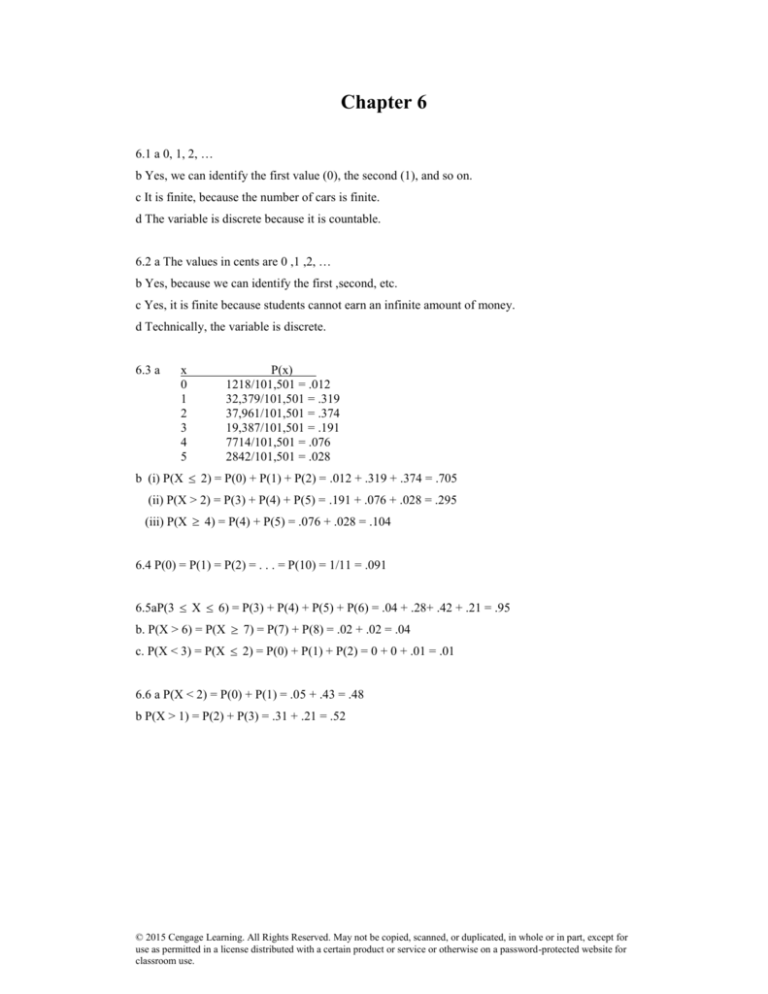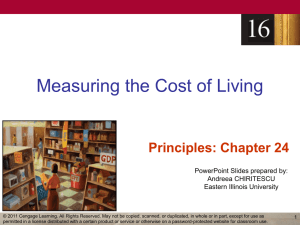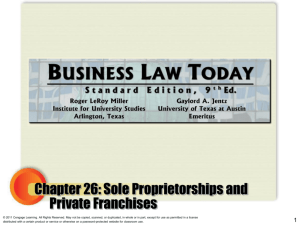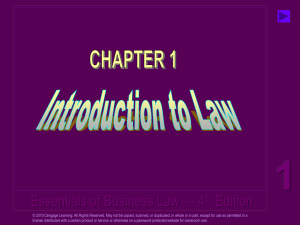
Chapter 6
6.1 a 0, 1, 2, …
b Yes, we can identify the first value (0), the second (1), and so on.
c It is finite, because the number of cars is finite.
d The variable is discrete because it is countable.
6.2 a The values in cents are 0 ,1 ,2, …
b Yes, because we can identify the first ,second, etc.
c Yes, it is finite because students cannot earn an infinite amount of money.
d Technically, the variable is discrete.
6.3 a
x
0
1
2
3
4
5
P(x)
1218/101,501 = .012
32,379/101,501 = .319
37,961/101,501 = .374
19,387/101,501 = .191
7714/101,501 = .076
2842/101,501 = .028
b (i) P(X 2) = P(0) + P(1) + P(2) = .012 + .319 + .374 = .705
(ii) P(X > 2) = P(3) + P(4) + P(5) = .191 + .076 + .028 = .295
(iii) P(X 4) = P(4) + P(5) = .076 + .028 = .104
6.4 P(0) = P(1) = P(2) = . . . = P(10) = 1/11 = .091
6.5aP(3 X 6) = P(3) + P(4) + P(5) + P(6) = .04 + .28+ .42 + .21 = .95
b. P(X > 6) = P(X 7) = P(7) + P(8) = .02 + .02 = .04
c. P(X < 3) = P(X 2) = P(0) + P(1) + P(2) = 0 + 0 + .01 = .01
6.6 a P(X < 2) = P(0) + P(1) = .05 + .43 = .48
b P(X > 1) = P(2) + P(3) = .31 + .21 = .52
© 2015 Cengage Learning. All Rights Reserved. May not be copied, scanned, or duplicated, in whole or in part, except for
use as permitted in a license distributed with a certain product or service or otherwise on a password-protected website for
classroom use.
6.7
a P(HH) = .25
b P(HT) = .25
c P(TH) = .25
d P(TT) = .25
6.8 a P(0 heads) = P(TT) = .25
b P(1 head) = P(HT) + P(TH) = .25 + .25 = .50
c P(2 heads) = P(HH) = .25
d P(at least 1 head) = P(1 head) + P(2 heads) = .50 + .25 = .75
6.9
© 2015 Cengage Learning. All Rights Reserved. May not be copied, scanned, or duplicated, in whole or in part, except for
use as permitted in a license distributed with a certain product or service or otherwise on a password-protected website for
classroom use.
6.10 a P(2 heads) = P(HHT) + P(HTH) + P(THH) = .125 + .125 + .125 = .375
b P(1 heads) = P(HTT) + P(THT) = P(TTH) = .125 + .125 + .125 = .375
c P(at least 1 head) = P(1 head) + P(2 heads) + P(3 heads) = .375 + .375 + .125 = .875
d P(at least 2 heads) = P(2 heads) + P(3 heads) = .375 + .125 = .500
6.11a = E(X) =
2 = V(X) =
xP (x) = 0(.4) + 1(.3) + 2(.2) + 3(.1) = 1.0
( x )
2
P( x ) = (0–1.0) 2 (.4) + (1–1.0) 2 (.3) + (2–1.0) 2 (.2) + (3–1.0) 2 (.1)
= 1.0
=
b.
2 1.0 = 1.0
x
0
1
2
3
y
2
5
8
11
P(y)
.4
.3
.2
.1
yP( y) = 2(.4) + 5(.3) + 8(.2) + 11(.1) = 5.0
=V(Y) = ( y ) P( y) = (2 – 5) (.4) + (5 – 5) (.3) + (8 – 5)
c. E(Y) =
2
=
2
2
2
2
2
(.2) + (11 – 5) (.1) = 9.0
2 9.0 = 3.0
d. E(Y) = E(3X + 2) = 3E(X) + 2 = 3(1) + 2 = 5.0
2 = V(Y) = V(3X + 2) = V(3X) = 3 2 V(X) = 9(1) = 9.0.
=
2 9.0 = 3.0
The parameters are identical.
6.12 a P(X
20) = P(20) + P(25) + P(30) + P(40) + P(50) + P(75) + P(100)
= .08 + .05 + .04 + .04 + .03 + .03 + .01 = .28
b P(X = 60) = 0
c P(X > 50) = P(75) + P(100) = .03 + .01 = .04
d P(X > 100) = 0
6.13 a P(X > 1) = P(2) + P(3) + P(4) = .17 + .06 + .01 = .24
b P(X = 0) = .45
c P(1
X 3) = P(1) + P(2) + P(3) = .31 + .17 + .06 = .54
© 2015 Cengage Learning. All Rights Reserved. May not be copied, scanned, or duplicated, in whole or in part, except for
use as permitted in a license distributed with a certain product or service or otherwise on a password-protected website for
classroom use.
6.14 = E(X) =
xP (x) = 0(.10) + 1(.20) + 2(.25) + 3(.25) + 4(.20) = 2.25
( x )
2 = V(X) =
2
2
2
2
P( x ) = (0–2.25) (.10) + (1–2.25) (.20) + (2–2.25) (.25) + (3–2.25)
2
(.13)
2
+ (4–2.25) (.20) = 1.59
=
2 1.59 = 1.26
6.15 E(X) =
xP (x) = 1,000,000(1/10,000,000) + 200,000(1/1,000,000) + 50,000(1/500,000)
+ 10,000(1/50,000) + 1,000(1/10,000) = .1 + .2 + .1 + .2 + .1 = .7
Expected payoff = 70 cents.
6.16 = E(X) =
2 = V(X) =
xP (x) = 1(.05) + 2(.12) + 3(.20) + 4(.30) + 5(.15) + 6(.10) + 7 (.08) = 4.00
( x )
2
2
2
2
2
2
P( x ) = (1–4.0) (.05) + (2–4.0) (.12) + (3–4.0) (.20) + (4–4.0) (.30)
2
2
+ (5–4.0) (.15) +(6–4.0) (.10) + (7–4.0) (.08) = 2.40
6.17 Y = .25X; E(Y) = E(.25X) = .25E(X) = .25(4.0) = 1.0
2
V(Y) = V(.25X) = (.25) V(X) =.0625(2.40) = .15
6.18 P(X = x) =
n!
p x (1 p) n x
x! (n x )!
a P(X = 3) =
10!
(.3) 3 (1 .3)103 = .2668
3! (10 3)!
b P(X = 5) =
10!
(.3) 5 (1 .3)105 = .1029
5! (10 5)!
c P(X = 8) =
10!
(.3) 8 (1 .3)108 = .0014
8!(10 8)!
3) – P(X 2) = .6496 – .3828 = .2668
b P(X = 5) = P(X 5) – P(X 4) = .9527 – .8497 = .1030
c P(X = 8) = P(X 8) – P(X 7) = .9999 – .9984 = .0015
6.19 a P(X = 3) = P(X
6.20 a .26683
b .10292
c .00145
© 2015 Cengage Learning. All Rights Reserved. May not be copied, scanned, or duplicated, in whole or in part, except for
use as permitted in a license distributed with a certain product or service or otherwise on a password-protected website for
classroom use.
6.21 P(X = x) =
n!
p x (1 p) n x
x! (n x )!
a P(X = 2) =
6!
(.2) 2 (1 .2) 62 = .2458
2! (6 2)!
b P(X = 3) =
6!
(.2) 3 (1 .2) 63 = .0819
3! (6 3)!
c P(X = 5) =
6!
(.2) 5 (1 .2)5 = .0015
5! (6 5)!
2) – P(X 1) = .9011 – .6554 = .2457
b P(X = 3) = P(X 3) – P(X 2) = .9830 −.9011 = .0819
c P(X = 5) = P(X 5) – P(X 4) = .9999 – 9984 = .0015
6.22 a P(X = 2) = P(X
6.23 a .24576
b .08192
c .00154
6.24 Table 1 with n = 25 and p = .3: P(X
10) = .9022
6.25 Table 1 with n = 25 and p = .75: P(X 15) = 1 – P(X 14) = 1 – .0297 = .9703
6.26 Table 1 with n = 25 and p = .10
0) = .0718
b P(X < 5) = P(X 4) = .9020
c P(X > 2) = P(X 3) = 1 – P(X 2) = 1 – .5371 = .4629
a P(X = 0) = P(X
6.27 Excel with n = 100 and p = .20: P(X > 25) = P(X
26) = 1 – P(X 25) = 1 – .91252
= .08748
6.28 a P(X = 0) =
e 2 2 0
e x
=
= .1353
0!
x!
b P(X = 3) =
e 2 2 3
e x
=
= .1804
3!
x!
c P(X = 5) =
e 2 2 5
e x
=
= .0361
5!
x!
© 2015 Cengage Learning. All Rights Reserved. May not be copied, scanned, or duplicated, in whole or in part, except for
use as permitted in a license distributed with a certain product or service or otherwise on a password-protected website for
classroom use.
6.29 a P(X = 5 with = 14/3) =
b. P(X = 1 with = 14/3) =
e 1 / 3 (1 / 3)1
e x
=
= .2388
1!
x!
6.30 a Table 2 with = 5: P(X
b Table 2 with = 10: P(X
3) = 1 – P(X 2) = 1 – .73062 = .26938
X 15) = P(X 15) – P(X 9) = .9780 – .5874 = .3906
6.32 a Table 2 with = 5: P(X
b Excel with = 25: P(X
10) = 1 – P(X 9) = 1 – .9682 = .0318
20) = 1 – P(X 19) = 1 – .9965 = .0035
6.31 a Excel with = 1.8: P(X
b Table 2 with = 9: P(10
e 14 / 3 (14 / 3) 5
e x
=
= .1734
5!
x!
10) = 1 – P(X 9) = 1 – .9682= .0318
25) = 1 – P(X 24) = 1 – .47340 = .52660
6.33 a Table 2 with = 1.5: P(X
2) = 1 – P(X 1) = 1 – .5578 = .4422
b Table 2 = 6: P(X < 4) = P(X
3) = .1512
6.34 a P(X = 0 with = 1.5) =
e x
e 1.5 (1.5) 0
=
= .2231
0!
x!
b Table 2 with = 4.5: P(X
5) = .7029
c Table 2 with = 3.0: P(X
3) = 1 – P(X 2 = 1 – .4232 = .5768
© 2015 Cengage Learning. All Rights Reserved. May not be copied, scanned, or duplicated, in whole or in part, except for
use as permitted in a license distributed with a certain product or service or otherwise on a password-protected website for
classroom use.












